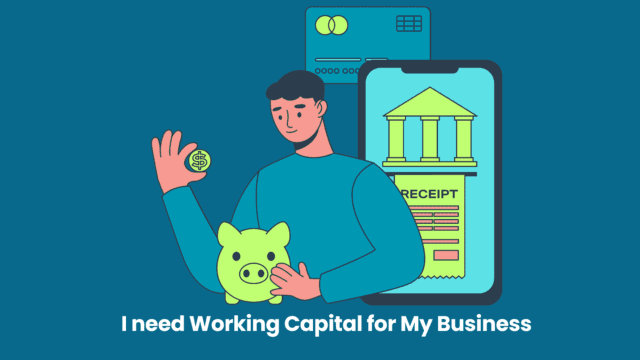Simply I ask myself today; Startup, when I need working capital for my business. It refers to the amount of money that a business requires to meet its day-to-day operational expenses. It is a measure of a company’s liquidity and its ability to cover short-term obligations. Working capital is crucial for ensuring the smooth functioning of a business by providing the necessary funds to pay for rent, utilities, inventory, employee salaries, and other operational costs.
In simpler terms, working capital represents the difference between a company’s current assets (such as cash, accounts receivable, and inventory) and its current liabilities (such as accounts payable and short-term debts). Also, It represents the funds readily available to cover immediate expenses and support the ongoing operations of the business.
Having adequate working capital is essential for a new business as it allows for the efficient management of cash flow, helps in meeting daily financial obligations, and provides a safety net for unexpected expenses or downturns in sales. Entrepreneurs need to estimate their working capital needs accurately and explore various funding options to secure the necessary funds. Regular monitoring and management of working capital is crucial to ensure the long-term sustainability and growth of the business.
When my startup I need Working Capital for Your Business
Starting a new business requires careful planning and financial resources, including working capital. Working capital is crucial for covering your daily operational expenses and ensuring the smooth functioning of your business.

Strategies for Maximizing Working Capital for Your Business
Here are some steps to help you acquire the necessary working capital:
Develop a comprehensive business plan:
Start by creating a detailed business plan that outlines your goals, target market, products or services, and projected expenses and revenues. A well-designed business plan will help you identify your working capital requirements.
Estimate your working capital needs:
Determine how much-working capital you will need to cover your initial expenses, such as rent, equipment, inventory, marketing, and employee salaries. Consider both short-term needs and ongoing expenses.
Explore funding options:
Once you have determined your working capital requirements, you can explore various funding options to secure the necessary funds. Some common options include:
- Personal savings: Using your savings is a common way to fund a new business. Evaluate your financial situation and determine how much you can invest in your venture.
- Traditional loans: Approach banks or credit unions to inquire about small business loans. Prepare a solid business plan and financial projections to support your loan application.
- Alternative financing: Consider alternative financing methods such as crowdfunding, angel investors, or venture capitalists. Also, These options often require a well-developed business idea and a convincing pitch.
- Government assistance: Research government programs or grants available for small businesses. Also, These can provide additional funding or access to resources.
Manage your expenses:
It’s essential to carefully manage your expenses to optimize your working capital. Consider cost-saving measures, negotiate favorable terms with suppliers, and track your expenses closely.
Monitor your cash flow:
Keep a close eye on your cash flow to ensure you have enough working capital to cover your expenses and identify any potential issues early on. Implement cash flow management strategies, such as incentivizing early payments from customers or implementing credit policies with suppliers.
Remember, maintaining a healthy level of working capital is an ongoing process. Regularly review your financial statements, adjust your projections as needed, and adapt your strategies to optimize your working capital position. With proper planning and sound financial management, you can secure the working capital you need to start and grow your business.
How Can I Maximize Working Capital for My Business?
Maximizing working capital for your business is essential for maintaining financial stability and ensuring smooth operations. Here are some strategies to help you achieve this:
Optimize inventory management:
Efficient inventory management is crucial for maximizing working capital. Minimize excess stock and identify slow-moving items to free up cash that can be used for other business needs. Also, Consider adopting just-in-time inventory practices and negotiating favorable terms with suppliers to reduce carrying costs.
Streamline accounts receivable:
Promptly invoice your customers and implement a strict credit policy to ensure timely payment. Offer incentives for early payment or consider offering discounts for early settlement. Regularly review your accounts receivable aging and follow up on overdue payments to improve cash flow.
Negotiate with suppliers:
Build strong relationships with your suppliers and negotiate favorable payment terms. Request extended payment terms or explore options for bulk purchasing to secure better pricing. Also, Take advantage of early payment discounts wherever possible to maximize savings.
Improve cash flow forecasting:
Accurate cash flow forecasting can help you identify potential shortfalls or surpluses in working capital. Use historical data and sales projections to estimate future cash inflows and outflows. Also, This allows you to plan and take necessary actions to optimize your working capital position.
Reduce operating expenses:
Regularly review your operational costs and identify areas where you can reduce expenses. Look for opportunities to negotiate better rates for utilities, insurance, rent, and other fixed costs. Implement cost-saving measures without compromising the quality of your products or services.
Evaluate financing options:
Consider different financing options to support your working capital needs. Compare interest rates and terms from various lenders to choose the most suitable option. These may include traditional loans, lines of credit, or alternative financing methods like invoice financing or merchant cash advances.
Monitor and measure key performance indicators:
Establish key performance indicators (KPIs) related to your working capital management. Monitor metrics such as cash conversion cycle, current ratio, and inventory turnover to assess the effectiveness of your strategies and identify areas for improvement.
Remember, working capital management is an ongoing process that requires constant monitoring and adjustments. Regularly review your financial statements and evaluate the impact of your strategies. By implementing these practices and continuously optimizing your working capital, you can improve the financial health and growth potential of your business.
Where Can I Find Working Capital for My Business?
Finding working capital for your business is essential for ensuring its smooth operation. Here are some common sources where you can find working capital:
#Personal Savings:
Consider using your savings to fund your business. Also, This can provide you with immediate access to capital without having to go through a loan application process.
#Traditional Business Loans:
Approach banks or credit unions to inquire about small business loans. Prepare a solid business plan and financial projections to support your loan application. Also, Traditional loans often come with competitive interest rates and structured repayment terms.
#Alternative Financing:
Explore alternative financing methods such as crowdfunding, angel investors, or venture capitalists. These options often require a well-developed business idea and a convincing pitch. Alternative financing can provide you with access to capital from individuals or groups who are willing to invest in your business.
#Government Assistance:
Research government programs or grants available for small businesses. Many governments offer financial assistance or access to resources to support the growth of small businesses. Also, These programs may include loans, grants, or tax incentives.
#Line of Credit:
Consider obtaining a line of credit from a financial institution. A line of credit provides you with access to funds that you can use whenever needed. You only pay interest on the amount you utilize, making it a flexible financing option.
#Trade Credit:
Speak with your suppliers about the possibility of obtaining trade credit. This means that you can receive goods or services from your suppliers and pay for them at a later date. Trade credit can help improve your cash flow by allowing you to use your working capital on other business expenses.
#Invoice Financing:
If your business invoices clients for goods or services, you can explore invoice financing. Invoice financing involves selling your accounts receivable to a third party at a discount. This can provide you with immediate access to cash instead of waiting for your customers to pay their invoices.
#Business Credit Cards:
Utilize business credit cards to cover short-term working capital needs. Business credit cards often come with benefits such as rewards programs, cashback incentives, and flexible payment terms.
Remember, finding the right source of working capital depends on various factors such as your business’s financial situation, funding requirements, and growth plans. Also, It’s important to carefully evaluate each option and choose the one that aligns with your business goals and financial objectives.
Bottom line
Working capital refers to the amount of money a business needs to cover its day-to-day expenses. It is crucial for the smooth functioning of a business and ensures the ability to meet short-term obligations. Working capital is calculated by subtracting current liabilities from current assets and represents the funds available to cover immediate expenses. Startups can maximize their working capital by developing a comprehensive business plan, estimating their needs accurately, exploring funding options, managing expenses, and monitoring cash flow.
Strategies for maximizing working capital include optimizing inventory management, streamlining accounts receivable, negotiating with suppliers, improving cash flow forecasting, reducing operating expenses, evaluating financing options, and monitoring key performance indicators. Sources of working capital include personal savings, traditional business loans, alternative financing, government assistance, lines of credit, trade credit, invoice financing, and business credit cards. It’s important for startups to carefully evaluate these options based on their financial situation and growth plans.

















